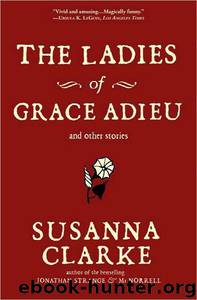Ladies of Grace Adieu by Susanna Clarke

Author:Susanna Clarke
Language: eng
Format: mobi
Tags: Fantasy, Adult, Historical, Science Fiction
ISBN: 9780747587033
Publisher: Bloomsbury
Published: 2006-10-17T10:00:00+00:00
THE FRIENDSHIP BETWEEN the eighteenth-century Jewish physician, David Montefiore, and the fairy, Tom Brightwind, is remarkably well documented. In addition to Montefiore's own journals and family papers, we have numerous descriptions of encounters with Montefiore and Brightwind by eighteenth - and early-nineteenth-century letter-writers, diarists and essayists. Montefiore and Brightwind seem, at one time or another, to have met most of the great men of the period. They discussed slavery with Boswell and Johnson, played dominoes with Diderot, got drunk with Richard Brinsley Sheridan and, upon one famous occasion, surprized Thomas Jefferson in his garden at Monticello.1
Yet, fascinating as these contemporary accounts are, our most vivid portrait of this unusual friendship comes from the plays, stories and songs which it inspired. In the early nineteenth century "Tom and David" stories were immensely popular both here and in Faerie Minor, but in the latter half of the century they fell out of favour in Europe and the United States. It became fashionable among Europeans and Americans to picture fairies as small, defenceless creatures. Tom Brightwind - loud, egotistical and six feet tall - was most emphatically not the sort of fairy that Arthur Conan Doyle and Charles Dodgson hoped to find at the bottom of their gardens.
The following story first appeared in Blackwood's Magazine (Edinburgh: September, 1820) and was reprinted in Silenuss Review (Faerie Minor: April, 1821). Considered as literature it is deeply unremarkable. It suffers from all the usual defects of second-rate early-nineteenth-century writing. Nevertheless, if read with proper attention, it uncovers a great many facts about this enigmatic race and is particularly enlightening on the troublesome relationship between fairies and their children.
Professor James Sutherland Research Institute of Sidhe Studies University of Aberdeen October 1999
For most of its length Shoe-lane in the City of London follows a gentle curve and it never occurs to most people to wonder why. Yet if they were only to look up (and they never do) they would see the ancient wall of an immense round tower and it would immediately become apparent how the lane curves to accommodate the tower.
This is only one of the towers that guard Tom Brighrwind's house. From his earliest youth Tom was fond of travelling about and seeing everything and, in order that he might do this more conveniently, he placed each tower in a different part of the world. From one tower you step out into Shoe-lane; another occupies the greater part of a small island in the middle of a Scottish loch; a third looks out upon the dismal beauty of an Algerian desert; a fourth stands upon Drying-Green-street in a city in Faerie Minor; and so on. With characteristic exuberance Tom named this curiously constructed house Castel des Tours saunz Nowmbre, which means the Castle of Innumerable Towers. David Montefiore had counted the innumerable towers in 1764. There were fourteen of them.
On a morning in June in 1780 David Montefiore knocked upon the door of the Shoe-lane tower. He inquired of the porter where Tom might be found and was told that the master was in his library.
Download
This site does not store any files on its server. We only index and link to content provided by other sites. Please contact the content providers to delete copyright contents if any and email us, we'll remove relevant links or contents immediately.
In Control (The City Series) by Crystal Serowka(35406)
The Wolf Sea (The Oathsworn Series, Book 2) by Low Robert(33910)
We Ride Upon Sticks by Quan Barry(33351)
Crowbone (The Oathsworn Series, Book 5) by Low Robert(32385)
The Book of Dreams (Saxon Series) by Severin Tim(32290)
The Daughters of Foxcote Manor by Eve Chase(22350)
Trainspotting by Irvine Welsh(20136)
Call Me by Your Name by André Aciman(19052)
Shot Through The Heart (Supernature Book 1) by Edwin James(17959)
The Secret History by Donna Tartt(16751)
The Girl from the Opera House by Nancy Carson(15017)
Sad Girls by Lang Leav(13389)
American King (New Camelot #3) by Sierra Simone(13050)
Pimp by Iceberg Slim(12988)
All the Missing Girls by Megan Miranda(12827)
The Betrayed by Graham Heather(11745)
The Betrayed by David Hosp(11720)
4 3 2 1: A Novel by Paul Auster(11113)
Still Me by Jojo Moyes(9962)
